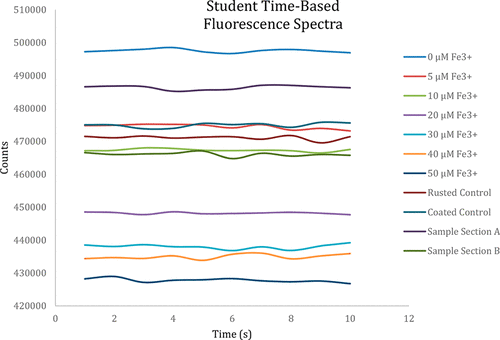当前位置:
X-MOL 学术
›
J. Chem. Educ.
›
论文详情
Our official English website, www.x-mol.net, welcomes your feedback! (Note: you will need to create a separate account there.)
Using Quenching To Detect Corrosion on Sculptural Metalwork: A Real-World Application of Fluorescence Spectroscopy
Journal of Chemical Education ( IF 3 ) Pub Date : 2018-03-15 00:00:00 , DOI: 10.1021/acs.jchemed.7b00726 Cory Hensen 1 , Tami Lasseter Clare 1 , Jack Barbera 1
Journal of Chemical Education ( IF 3 ) Pub Date : 2018-03-15 00:00:00 , DOI: 10.1021/acs.jchemed.7b00726 Cory Hensen 1 , Tami Lasseter Clare 1 , Jack Barbera 1
Affiliation

|
Fluorescence spectroscopy experiments are a frequently taught as part of upper-division teaching laboratories. To expose undergraduate students to an applied fluorescence technique, a corrosion detection method, using quenching, was adapted from authentic research for an instrumental analysis laboratory. In the experiment, students acquire fluorescence spectra of sensing molecules in the presence of mock sculpture samples and discuss the condition of the sculptures based on the levels of soluble iron detected. This real-world-based experiment allows students the chance to engage with ongoing research and further understand the challenges with early detection of corrosion. Most students successfully completed the experiment, wrote a journal-quality report, and met the learning outcomes.
中文翻译:

使用淬火检测雕刻金属工件上的腐蚀:荧光光谱的实际应用
荧光光谱实验经常作为高阶教学实验室的一部分进行教学。为了使大学生能够接触到应用的荧光技术,采用了淬火的腐蚀检测方法,改编自仪器研究实验室的真实研究。在实验中,学生在模拟雕塑样本的存在下获取感测分子的荧光光谱,并根据检测到的可溶性铁水平讨论雕塑的状况。这个基于现实世界的实验使学生有机会参与正在进行的研究,并进一步了解腐蚀的早期检测所面临的挑战。大多数学生成功完成了实验,写了期刊质量报告,并达到了学习成果。
更新日期:2018-03-15
中文翻译:

使用淬火检测雕刻金属工件上的腐蚀:荧光光谱的实际应用
荧光光谱实验经常作为高阶教学实验室的一部分进行教学。为了使大学生能够接触到应用的荧光技术,采用了淬火的腐蚀检测方法,改编自仪器研究实验室的真实研究。在实验中,学生在模拟雕塑样本的存在下获取感测分子的荧光光谱,并根据检测到的可溶性铁水平讨论雕塑的状况。这个基于现实世界的实验使学生有机会参与正在进行的研究,并进一步了解腐蚀的早期检测所面临的挑战。大多数学生成功完成了实验,写了期刊质量报告,并达到了学习成果。



























 京公网安备 11010802027423号
京公网安备 11010802027423号